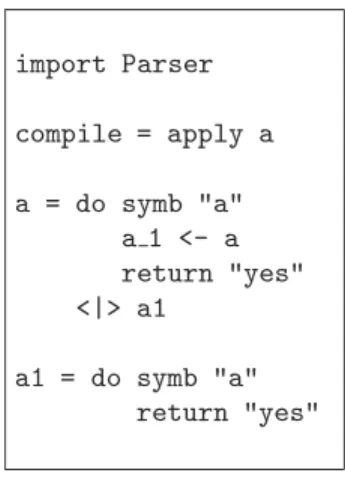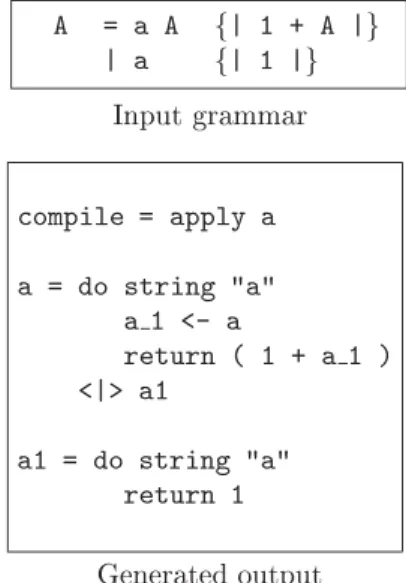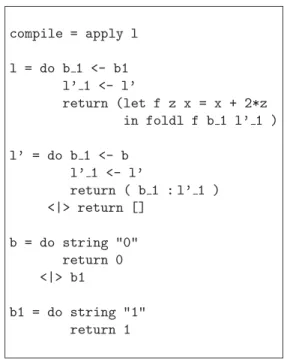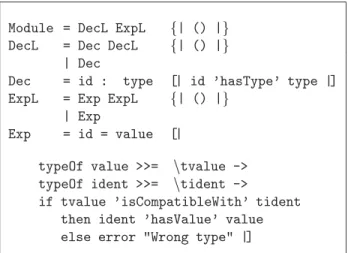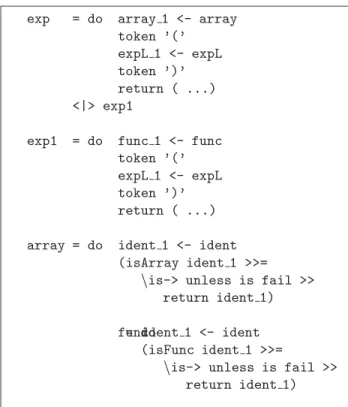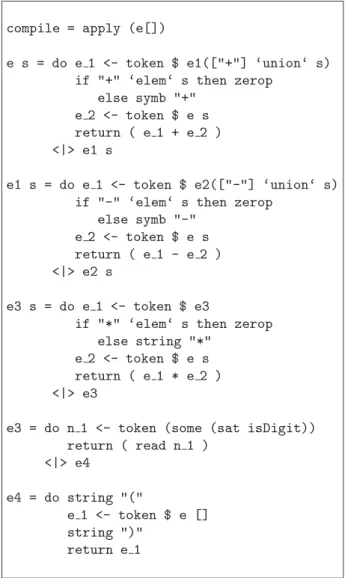!
+
8
-/
-
7 /
,
9:
;
<
-9
:/ 8
7
=
3
>
Æ
?
8
< #
6
Parser Generator
Carlos Camarão
Universidade Federal
de Minas Gerais
31270-010 - Belo Horizonte
MG - Brasil
camarao@dcc.ufmg.br
Lucília Figueiredo
Universidade Federal
de Ouro Preto
35100-000 - Ouro Preto
MG - Brasil
lucilia@dcc.ufmg.br
Hermann Rodrigues
Universidade Federal
de Minas Gerais
31270-010 - Belo Horizonte
MG - Brasil
hermann@dcc.ufmg.br
#$ %&℄ #%( %) * )℄ +
,
! -. $/
-. 0/
.123!$44%"3#5℄
6
6%
! - /
7
!-/
!
Abstract
<
½
½
-
½
/ +
"
<
8
- /
@
A
@ 7
B
+
<
- /
8
BA-/
8 7
-
/ +
7
-/
C!
D
E
>%
8
"
8
>%<
·
-
/D
D
+
Æ
%
+
-
/
,!
<
1
"
-
/ +A
<
>
#
> #
#
8
> C
$%!- C !/
3
- #$ %0℄/ &
&
#%*℄-
&
& /
F
- /
22-/
2G-/ H
$ " "%
D
$ %
- / ,
>$
!
7-
/
"
!
<
'
'
%
>
6II(
#
8
!
$ # %
!
E
>$<
(
8 '
''(
A3 Æ
<
E
,
1 !
H
) $ *%
)( $ *%
$ ) )( %
) $ *%
*
*
>5<
3 / Æ
+
22-/
2G-/
, <
+) +) +) +)(
+) *
*
+)
7
>5
"
,
,$ - %-$ - %℄ =
D
F ,
.5!
.0
.&
.*
H
<
; F
/012 Î
Î
J
J
£
7
-JÎ/
£
7
-JÎ/
£
7
7 -
/
!
- 33 / H
.&
<<6 ¼
<<6 6 ½
½
6-JÎÈ/
>0
-/ 7
- 7
97 7 : @
¼
6
¼
/
È-/
7
- / .
.5
-/ >
>&
##℄℄
6 ##6 ½ ½ ℄℄ -%/ ½ ½ 6-/
##6℄℄
6 ### ½ ℄℄ ½ ½ ## ℄℄ ℄ -$/ 6 ½ ½ ¾ ¾ ·½ J
6%I%
-/6
½ ½ ¾ ¾ ·½ J 6%
##6 ½ ½ ℄℄ 6
##6 ½
½ ℄℄
"- ½
/
##6 ¾
¾ ℄℄
"- ½
/ -
¾ /
##6 ℄℄ - ½ / !!! - ½ / - /
"-
/
6%
-5/
-/6
-/ 6 /
! . 7 > 7 Æ 7 2 .& 2 <
-/ 6
-/ 6
-/ 6
-/
-/ 6 - 6/
-/ 6
½ ½ 6-/ - / % - / D "
1 1 1 #
4
! E
>*
"
"
" "
$ 5 " 5 #
"%
!
4
"
" "
$ 3 " %
,℄ ! >*< 2 #%℄ + 8
Figure 4: Semantics of Mímicos input
Figure 5:
parsed
substring
-/ -/
-Ë/ Ë
-Ë/ Ë
-Ë/
Ë Ë
6 ½ ½ È-/ ËË ¼ Ë/ 6) Ë ¼
6 Ë
6 % -/ >)< - / H ,
>7
-/ - / > >)
+ 6
-/ + 7 > (
>(-
/ 0 - 0
Î/ 6 %-
>K/ 8
- / >K
6 0
0 ¼ ¼ 6 % 6 % 7 -0
Î0
6J
/ # $% $ > ( ¼
/ 2
6 % 2 # ¼ ℄ - / ¼ / ¼ / ¼ / ¼ ¼ ¼ 2 ¼ 2 < ¼ ,℄ ¼ 2 ¼ 2 < ¼ ,℄ 2 0 1 2 0 1
6% 1
6 0 0 Î ¼ ¼ ¼ ¼ ¼
>K< &$
Figure 7: Function
first
G
Figure 8: Form of directly left-recursive productions
6%<
6
/
¼
5 "
,57- "70
℄
0
/
¼
5 "
,57℄
" 5
-
6%/
< / %
/
D/0
2
0
2
0
-6%/
<
/ / # (8
/
/ 4
2
D
Æ "
-/ <
/ $ / 8 (
$ % #
# %
/ $/- %
/ 4
1
>%4
H <
' ( 2
¼
7
½
>
¼
##℄℄
¼
6##℄℄
½
$ 5 " " # (85
%
$ 3 %
,℄
! 4
4
!
>%4< E
< .
½
¼
¼
H 6 6 %
, % %
- 3
/ H
0
½
½
½
¼ ½
¼ ½
½ 2
½
1
½
0
06 J
£
H
##6 ¼
℄℄
¼
6##/℄℄
½
##0℄℄
¼
6##0℄℄
½
J
£
-
½
B
¼
/
-
Æ /<
)( 8" 5 "7
$ "% $ 5 $ "%%5
2 6##6
¼ ℄℄
¼
<
##℄℄ ¼
6 ##℄℄
½ 6
¼
-0/ 6
¼
-/6
##℄℄
¼
6##60 ¼
℄℄
¼
6##6 ¼
℄℄ ¼
6
< ##℄℄
½
6## / ℄℄
½
6 -##/℄℄
½ / -## ¼ ℄℄ ½ /
5 " 6#5"0℄
.## ¼ ℄℄ ½ 6,℄ ##℄℄ ½
6 ,℄6
¼
-/6
H
J
£
/ 6
½ ¾ ¼ 0/6 6% ¼
-0/
¼
-/6
##℄℄
¼ 6 ##℄℄
½
6 /
> 6 %
½ 0/ 6 2
6 ##/℄℄ ½
6 ##0℄℄
¼
6
% H
<
* 1< 6% <
##℄℄
¼
6##60 ¼
℄℄
¼
6##60℄℄ ¼ 6###℄℄
¼ ½ 0℄ ##℄℄ ¼ 6# ½ 0℄ H ##℄℄ ½
6##6/ ¼ ℄℄ ½
6 -##/℄℄
½ / -## ¼ ℄℄ ½ /
5 " 6#5"0℄
F< ## ¼ ℄℄ ½
6## ¼ 62 ¼ 2< ¼ ℄℄ ½ 62<
¼ ###2℄℄
½ 2 ##
¼ ℄℄ ½ ¼ ℄
6##2℄℄ ½ 3 ,℄ 6# ½ ℄ ## ¼ ℄℄ ½
6## ¼ ,℄℄℄ ½ 6,℄ ##℄℄ ½
6 -##/℄℄ ½
/# ½
℄
6 -
½ /,℄ 6 ½ 6# ½ 0℄
* 8 H<
##℄℄
¼
6##60 ¼
℄℄
¼
6##60℄℄ ¼ 6###℄℄
¼ ½ ¡¡¡ ½
##0℄℄
¼
0℄
6###℄℄ ¼ ½ ¡¡¡ ½ 0℄ ##℄℄ ½
6##6/ ¼ ℄℄ ½ 6
< 6 -##/℄℄
½ /-## ¼ ℄℄ ½ /
5 "6#5"0℄
1 ##℄℄ ¼ ½ ¡¡¡ ½ 6##℄℄
½ ½ ¡¡¡ ½
##0℄℄ ¼
6##0℄℄ ½ < ###℄℄ ¼½¡¡¡ ½
##0℄℄ ¼
0℄6
###℄℄
½½¡¡¡ ½
##0℄℄ ½ 0℄ . ##℄℄ ½½¡¡¡ ½ 6 -##/℄℄ ½ /-## ¼ ℄℄ ½ ½ ¡¡¡ ½ / < ##℄℄ ¼
6# -##/℄℄ ½ / -## ¼ ℄℄ ½½¡¡¡ ½ /
##0℄℄ ½ 0℄ 6 -##/℄℄ ½ /-## ¼ ℄℄ ½½¡¡¡ ½ / / %##℄℄ ¼ 6##℄℄
½ >( >%% 6 ½ 0 ½ ½ 0 ½ ¼ ½ ¼ 6% 6% 7 -0 0 6 J · /
(( )$% -7
/ ¼ ½
¼¼ ½
¼
¼¼
-¼ ½
¼¼ ½
/ -¼
¼¼
/6
-/
>%$< + $
> K
/ >%$
-/
-/ <
-/ 6
-/
-Ë/6 Ë
½ Æ
¾ Æ
½
½
6È-/
Æ7
6%
6
6//
/Ë
-/Ë/
6//
/ Ë
-//
/
8
A
D
9 : ;" $%
: : : $%
:
: 3 , )* ℄
;" ;" ;" $%
;"
;" ' ,
< ' '
<
' +=)
) )> '
=! ℄
> %5< , - ./$$
8
7
> >%5
;
+ C#!C℄!
.
!
! >
>%5
:;":9;"
>%0
8
9 ,:
+
Figure 12: Handling indirect left-recursion
!
8
9
>
.
!
?<
" "
$
" "
$%%
$
$%%
$
$%%
@ 3
$ )* %
" AAA
AAA AAA
(
+
-#%5%$℄/
"
>
> %& !
;" $ ;" % AAA
B $ ;" % AAA
,
℄
B , B
℄
(" ,
>%*
8
+ 8=
!
6
,
+ 7
9D 7
Figure 14: Compiler for tiny language
"
@ $
" "
@ %
$ AAA%
"
"
@ $
" "
@ %
$ AAA%
$
%
$B
%
(0 1
%
!
"
- # 8
/
#
8
$ %
8
F
-
!
/
7
8
@ 7
>
7
>%)
6
½
½
½
½
½
¼ ½
¼
6%
J
6 ½
½
J
6%
Î 6%
(2 34 $%$
/1
E
> %( H
D
<
A #
A
A 8
$ %
# 8
>%K 3
@@
L D 5
C
"
( ,
Figure 16: Strict parsing and the use of context sensitive
conditions for parsing control
3 8
G <
,
>
> %K
D
( D C D
(
(
( .
(
2
>%(
,
8 9:
8
-/
> <
#
8
$ %
A #
A 8
$ %
. 9
:
-
/B
-
/ "
.
@ E $, # ℄ %
# ) 5
# $#%
4
( @ E $, # ℄ %
# ) 5
# $#%
4 (
( @ E
$ 4 ( %
@ E ($, ℄ %
) 5
$%
(
4
( @ E D$, ℄ %
) 5
$%
4 (
( @ E
$ 4 ( %
( @ E D
8 ) 5
! 8
( @ E
$ 8 ( %
D
D @ $ $ :!%%
$ %
C
C ! $
@ E ,℄
! %
$,℄%
@ E $, # ℄ %
# ) 5
#
( @ E
$ # ( %
@ E ($, ℄ %
) 5
( @ E
$ ( %
(
D @ E D
8 ) 5
! 8
( @ E
$ 8 ( %
D
D @ $ $ :!%%
$ %
C
C ! $
@ E ,℄
! %
> %K< 1
% /1
H
+
MG2
H
+
H
- /
<
,
22-/2G-/
+
!
22-/
2G-/ >
N
Æ
!
!Æ
Æ
-#%0℄/
;
-
7/
!
;
+ L
- #%4( %% &℄/ H
N #%4℄
#&℄ Æ
#%0 K0℄ Æ
/ =
8
+
> < /
,
/
/ 9 :
#%℄ G . + O + PB ; M
!"
! +H %K(*
#$℄ G1#$
% 3 %KK( $
#5℄ " "Q 2 > +
"" " 8&
'()*+,,- ./(0 '
)1*0R)K$44%
#0℄ " 2, 2 > 8
$ $2 # ' $
) .)3' -4++
'/ 1%KKK
#&℄ +E . < 3
E <SS SS
$444
#*℄ E
5 $ $<$5$R
505%KK$
#)℄ E ?L
F=".GK*0%KK*
#(℄ 326 783
%K(K
#K℄ ;2L 3
<SS SQS
#%4℄ PG2 ;1
)8 9 =!G T+%KK$
#%%℄ + 8
" E . 8 &
'()*+,,,.#/(0 '
)1$&KR$**$444
#%$℄ 3G U+
-/< -/
8 #
%KK0
#%5℄ 3 G U + < +
-/ ' :
;$&-)/<)(KR(%4%KK&
#%0℄ .; . 3 "
8 < '#7)<3 % =
%%5R%$($444
#%&℄ . % ! $
+H %KKK
#%*℄ 3 H
8$ )
< )3' +,- %%5R
%$(%K(&
#%)℄ 3 H "
''$-0/<0*%R
0K5%KK4
#%(℄ 3 H > 3
